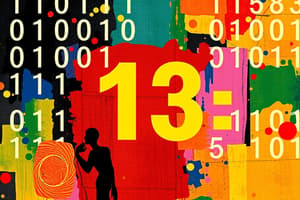Podcast
Questions and Answers
What is the base of the binary numerical system?
What is the base of the binary numerical system?
- Base-8
- Base-10
- Base-2 (correct)
- Base-16
What is the value of the binary number 101 in decimal?
What is the value of the binary number 101 in decimal?
- 5 (correct)
- 6
- 7
- 3
What does each new position to the left in binary represent?
What does each new position to the left in binary represent?
- Subtracts 1
- Adds 1
- Halves the value
- Doubles the value (correct)
If a binary number has the digits 110, what is its decimal equivalent?
If a binary number has the digits 110, what is its decimal equivalent?
What is the result of adding the binary numbers 1011 and 110?
What is the result of adding the binary numbers 1011 and 110?
Which position in binary has the highest value?
Which position in binary has the highest value?
Flashcards are hidden until you start studying
Study Notes
Understanding Binary Numbers
Binary numbers form the foundational language of computers and digital systems. They're composed of just two digits: 0 and 1. In this guide, we'll explore the basics of binary, including converting binary to decimal, the structure of the binary numerical system, and binary addition.
Binary Numerical System
Binary numbers are based on the base-2 system, where each digit has a value of either 0 or 1. In contrast, our familiar decimal system is based on the base-10 system, using digits 0-9.
To count in binary, we start at 0 and increment by 1 for each position. For example:
- 0 (zero)
- 1 (one)
- 10 (two)
- 11 (three)
- 100 (four)
- 101 (five)
- 110 (six)
- 111 (seven)
Each new position to the left doubles the value of the previous position. In binary, the positions are called bits (short for binary digits).

Converting Binary to Decimal
To convert binary to decimal, you multiply each bit by its position's value and then add up the results. For example, to convert the binary number 1101 to decimal:
- Multiply the rightmost bit (1) by 1 (since it's in the 1's place): 1 * 1 = 1
- Multiply the next bit (1) by 2 (since it's in the 2's place): 1 * 2 = 2
- Multiply the next bit (0) by 4 (since it's in the 4's place): 0 * 4 = 0
- Multiply the leftmost bit (1) by 8 (since it's in the 8's place): 1 * 8 = 8
Now, add up the results: 1 + 2 + 0 + 8 = 11. So, 1101 in decimal is 11.
Binary Addition
Binary addition follows a simple set of rules. To add two binary numbers, you can follow these steps:
- Start from the rightmost bits and work your way to the left.
- For each pair of bits, add the two numbers and carry over any excess value (using the same rules as decimal addition).
For example, let's add 1011 (9) and 1101 (11) in binary:
- 1 + 1 = 0 (with a carry of 1)
- 0 + 1 + 1 = 2
- 1 + 0 + 0 = 1
- 1 + 1 + 1 = 3
Now, add the carry: 0 + 1 = 1
So, the binary addition of 1011 and 1101 is 10110. This is equivalent to the decimal number 20 in decimal.
Binary numbers are a fundamental part of computer science and digital systems. With an understanding of binary, you can delve deeper into computer systems, programming, and other related fields.
Studying That Suits You
Use AI to generate personalized quizzes and flashcards to suit your learning preferences.




